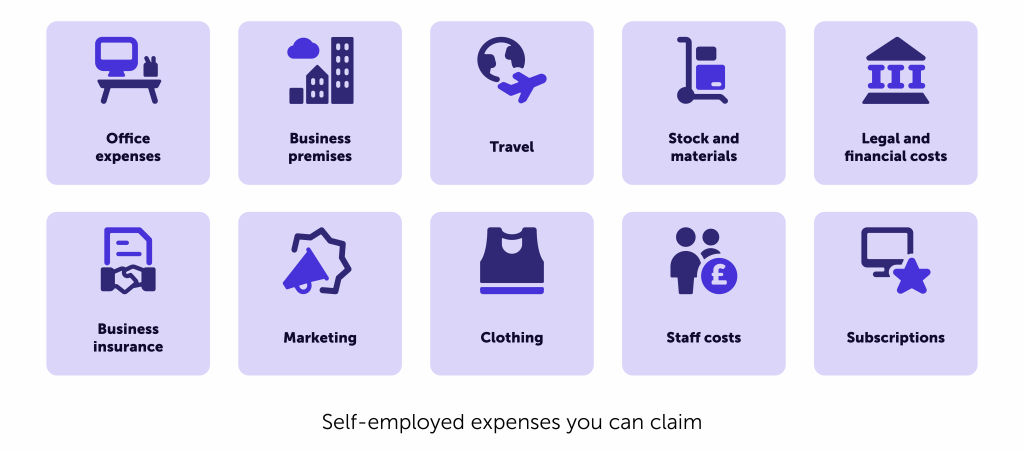UK income tax is charged on income and earnings made by individuals in any given tax year.
The rates and thresholds are set by the UK government (and the Scottish Parliament), and tax is collected by HMRC. These rates can change with announcements by the chancellor.
This guide covers everything you need to know about current income tax rates and bands for the self-employed, including:
- a definition of income tax
- income tax bands
- UK income tax rates 2024-25
- how to calculate income tax
- changes to cash basis accounting rules
- how you can reduce income tax
- how to file income tax
- how to pay income tax
Our Self Assessment hub has everything you need to know about filing your tax return.
What is income tax?
Income tax is collected by HMRC from employees and the self-employed.
For employees, income tax is generally deducted at source. This means it’s taken out of an employee’s salary before it’s paid to them. Your tax code is used to tell your employer how much to deduct from your wages.
But self-employed income tax is different. You pay income tax and National Insurance through Self Assessment by 31 January each year.
This means you need to record your earnings and let HMRC know what you owe in an annual tax return.
You can also deduct business expenses to pay less tax, which means the self-employed pay income tax on trading profits rather than total income.
Keep in mind that you’ll also need to pay National Insurance through your Self Assessment, too.
Income tax bands – what do you need to know?
Self-employed income tax rates are the same as tax rates for employees.
Most people get a standard tax-free personal allowance, with income tax thresholds, rates, and bands applying to everybody.
The personal allowance has been frozen at £12,570 until 2028. So it’s worth remembering that this could lead to a higher tax bill if your earnings increase (for example, if you grow your business or make more money as a result of rising prices).
Your income tax personal allowance changes if your adjusted net income (income before any personal allowances and less certain tax reliefs) is above £100,000. It goes down by £1 for every £2 above £100,000. So, if you earn £125,140 or above, your personal allowance is zero.
It’s also worth noting that high earners that pay income tax through PAYE also have to file a Self Assessment tax return (even though they’re employed). The income tax threshold for employees having to file a Self Assessment increased to £150,000 from 2023-24.
You don’t pay a single income tax rate on your trading profits. Instead, you pay the appropriate rate on your trading profits within each bracket.
For example, if you’re filling out your next Self Assessment in January 2025 and your trading profits were £50,500 in 2023-24, you pay:
- no income tax on £12,570 of your trading profits
- 20 per cent on the next £37,700
- 40 per cent on £230
Income tax rates and bands 2024-25
Income tax is a devolved responsibility by the UK government, so there are different rates and bands depending on where you live.
What percentage is income tax in England, Wales, and Northern Ireland?
| Band | Taxable income | Tax rate |
| Personal allowance | Up to £12,570 | 0% |
| Basic rate | £12,571 to £50,270 | 20% |
| Higher rate | £50,271 to £125,140 | 40% |
| Additional rate | Over £125,140 | 45% |
Here’s an example of how your personal allowance decreases above £100,000:
- you need to pay tax on £110,000 of earnings
- you pay the higher rate (40 per cent) on £10,000 (£4,000)
- you also pay the higher rate (40 per cent) on your £5,000 lost personal allowance (£2,000)
What are the Scottish income tax rates?
Income tax is devolved to the Scottish Parliament, which means it sets the rates and thresholds. Scottish income tax rates 2024-25 are detailed in the table below.
| Band | Taxable income | Tax rate |
| Personal allowance | Up to £12,570 | 0% |
| Starter rate | £12,571 to £14,876 | 19% |
| Basic rate | £14,877 to £25,561 | 20% |
| Intermediate rate | £25,562 to £43,662 | 21% |
| Higher rate | £43,663 to £75,000 | 42% |
| Advanced rate | £75,001 to £125,140 | 45% |
| Top rate | Over £125,140 | 48% |
How to calculate income tax in the UK
Income tax is calculated based on income, and there are different rates and thresholds for different portions of your income. As mentioned above, the UK basic rate is 20 per cent and the higher rate is 40 per cent.
How much tax income do I pay if I’m self-employed?
This is an example self-employed tax calculation for 2023-24 if someone has:
- no income from employment through PAYE
- £58,000 in self-employed income
- £5,000 in business expenses
- been self-employed for the full tax year
These rates and allowances are based on current frozen UK income tax rates and thresholds (assuming a personal allowance of £12,570). This tax calculation includes income tax and self-employed National Insurance:
- £7,540 (20 per cent) on self-employment income between £12,570 and £50,270
- £1,092 (40 per cent) on self-employment income between £50,270 and £53,000 (£58,000 less £5,000 business expenses)
- Class 4 National Insurance at six per cent on £37,700 – which is £2,262
- Class 4 National Insurance at two per cent on the remainder of income – which is £55
- No Class 2 National Insurance
This comes to a total income tax and National Insurance bill of £10,949.
The self-employed person makes £42,051 after tax and expenses. This calculation was completed using an income tax calculator for the self-employed from Tax Scouts.
The example above is just an illustration and your personal circumstances will be different. If you’re not sure, speak to a professional to help with your calculations.
Changes to cash basis accounting rules
Since April 2024, new rules mean cash basis accounting is the default way you calculate your trading profits (instead of accrual accounting). You previously had to opt-in to this scheme and would have to stop using cash basis if your turnover went over £300,000.
The government says this is a simplified accounting option and will enable small businesses and the self-employed to continue using it as they grow.
Read our guide to the difference between cash basis accounting and cash accrual accounting for more information.
How to reduce income tax if you’re self-employed
As mentioned, you don’t pay income tax on total income. Instead, you can deduct a number of allowable business expenses to calculate your total trading profits. This means that it’s important to record and deduct all of your allowable expenses to pay the right amount in tax.
Generally, you can claim expenses that are wholly and exclusively for business purposes – for example, accounting, business insurance, a business phone, and so on.

You can read more about reducing income tax by claiming expenses in our guide to allowable expenses for the self-employed.
There’s also lots of HMRC guidance about business expenses and you should check whether there’s any information from trade bodies specific to your industry.
Filing an income tax return when you’re self-employed
You need to complete an annual Self Assessment tax return by 31 January each year (it’s earlier if you file on paper, but HMRC is gradually making the entire tax system digital). You’ll also need to pay any tax due by 31 January.
You register for Self Assessment when you first go self-employed. There are penalties for doing this late, so make sure that you register promptly.
You’ll receive a notice to file each year. You can file your return at any point from then – there’s no reason to leave it until the last minute. Most people file their Self Assessment tax return online. You’ll need a Government Gateway login if you haven’t got one yet, so get this sorted as soon as possible.
What information do you need to supply?
When you log in to file your return, you’ll need to answer a series of questions about the nature of your business, any other income you’ve received (including foreign income), and your expenses and income. You can choose to write expenses as a single figure, or if your accounts are more complicated, you can break them down.
A successful tax return relies on meticulous record keeping throughout the tax year. You need to keep track of invoices and receipts, and make sure that they’re properly filed. Most self-employed people use bookkeeping and accounting software to help them do this.
If you aren’t sure about income tax or filing your tax return, it’s a good idea to get help from a qualified professional.
Read more about your Self Assessment tax return in our comprehensive guide.
How do you pay self-employed income tax?
Employees pay tax automatically through PAYE, but self-employed people need to pay after filing their Self Assessment tax return. This also applies to company directors. HMRC should calculate your tax bill for you.
If you’re struggling to pay your tax bill, don’t put off speaking to HMRC. They might be able to work out a payment plan for you to pay your bill in instalments – this is called a Time to Pay arrangement.
But if you can pay your tax bill by 31 January, you should. HMRC will charge you interest on late payments, so a payment plan will end up costing you more in the long run.
You should also remember payment on account. Under this system, you pay 50 per cent of your last tax bill towards your next year’s liability. There’s also a payment on account due in July. Payments on account can be a surprise in your first year, but it’s important that you budget for them.
Do you have any unanswered questions about UK income tax rates for the self-employed? Let us know in the comments below.
More tax guides for the self-employed
Photograph: Rido/stock.adobe.com
Ready to set up your cover?
As one of the UK’s biggest business insurance providers, we specialise in public liability insurance and protect more trades than anybody else. Why not take a look now and build a quick, tailored quote?
